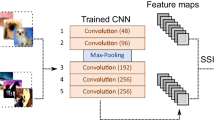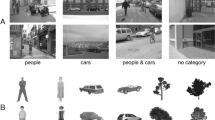Abstract
Occlusion is currently at the centre of analysis in machine vision. We present an approach to it that uses attention feedback to an occluded object to obtain its correct recognition. Various simulations are performed using a hierarchical visual attention feedback system, based on contrast gain (which we discuss as to its relation to possible hallucinations that could be caused by feedback). We then discuss implications of our results for object representations per se.
Preview
Unable to display preview. Download preview PDF.
Similar content being viewed by others
References
Zitnick, C.L., Kanade, T.: A Cooperative Algorithm for Stereo Matching and Occlusion Detection. IEEE Trans. Patt. Anal. Mach. Intel. 22, 675–684 (2000)
Fukushima, K.: Recognition of partly occluded patterns: a neural network model. Biol. Cybern. 84, 251–259 (2001)
Ito, M., Komatsu, H.: Representation of Angles Embedded within Contour Stimuli in Area V2 of Macaque Monkeys. J. Neuroscience 24, 3313–3324 (2004)
Pasupathy, A., Connor, C.E.: Shape Representation in Area V4: Position-Specific Tuning for Boundary Configuration. J. Neurophysiol. 86, 2505–2519 (2001)
Taylor, J.G., Hartley, M., Taylor, N.R.: Attention as Sigma-Pi controlled ACh-based feedback. In: Proc. of IJCNN 2005 (2005)
Lanyon, L.J., Denham, S.L.: A model of active visual search with object-based attention guiding scan paths. Neural Netw. 17, 873–897 (2004)
van der Velde, F., de Kamps, M.: From Knowing What to Knowing Where: Modeling Object-Based Attention with Feedback Disinhibition of Activation. J. Cog. Neurosci. 13, 479–491 (2001)
Reynolds, J.H., Chelazzi, L., Desimone, R.: Competitive mechanisms subserve attention in Macaque areas V2 and V4. J. Neurosci. 19, 1736–1753 (1999)
Taylor, J.G., Rogers, M.: A control model of the movement of attention. Neural Netw. 15, 309–326 (2002)
Taylor, N.R., Hartley, M., Taylor, J.G.: The Micro-Structure of Attention (2006) (accepted for CNS 2006)
Taylor, N.R., Hartley, M., Taylor, J.G.: Analysing Attention at Neuron level (2006) (accepted for BICS 2006)
Grossberg, S., Raizada, R.D.: Contrast-sensitive perceptual grouping and object-based attention in the laminar circuits of primary visual cortex. Vision Res. 40, 1413–1432 (2000)
Deco, G., Rolls, E.T.: Neurodynamics of biased competition and cooperation for attention: a model with spiking neurons. J. Neurophysiol. 94, 295–313 (2005)
Author information
Authors and Affiliations
Editor information
Editors and Affiliations
Rights and permissions
Copyright information
© 2006 Springer-Verlag Berlin Heidelberg
About this paper
Cite this paper
Taylor, N.R., Panchev, C., Hartley, M., Kasderidis, S., Taylor, J.G. (2006). Occlusion, Attention and Object Representations. In: Kollias, S.D., Stafylopatis, A., Duch, W., Oja, E. (eds) Artificial Neural Networks – ICANN 2006. ICANN 2006. Lecture Notes in Computer Science, vol 4131. Springer, Berlin, Heidelberg. https://doi.org/10.1007/11840817_62
Download citation
DOI: https://doi.org/10.1007/11840817_62
Publisher Name: Springer, Berlin, Heidelberg
Print ISBN: 978-3-540-38625-4
Online ISBN: 978-3-540-38627-8
eBook Packages: Computer ScienceComputer Science (R0)




